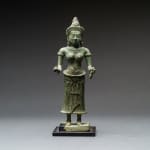Khmer Bronze Sculpture of the Goddess Uma, 12th Century CE - 13th Century CE
Bronze
height 21.3 cm
height 8 3/8 in
height 8 3/8 in
FZ.384
Further images
The goddess Uma, also known as Parvati, daughter of the mountains, was the consort of Shiva. When she finally attracted Shiva, after a long and physically grueling courtship, she shared...
The goddess Uma, also known as Parvati, daughter of the mountains, was the consort of Shiva. When she finally attracted Shiva, after a long and physically grueling courtship, she shared with her the secrets of the world, a conversation that would lead to the dispersal of this elite knowledge amongst the wise. Shiva’s exploits were represented on the relief carvings of Angkor Wat, the center of the Khmer dynasty and the largest religious monument in the world. Thus, Uma was a favored goddess of Khmer artists for her important stature in the Hindu hierarchy. This extraordinary bronze sculpture depicts the goddess standing straight, holding a rolled up scroll in her left hand and the stem of a fragmented plant in her right. She is adorned by an elaborate floral diadem and necklace of pedal-shaped pendants. The intricate carving of her conical coiffure imitates the form of a lotus bulb. Her ears droop down to her shoulders from the weight of her ear ornaments. She wears two bands high up on her arms, both decorated with rosettes in the center, and two heavy anklets just above her feet. Her voluptuous torso is exposed while a long, pleated sarong covers her lower body, supported by a belt decorated by suspended leaf-shaped pendants and two central rosettes. A slight over-fold wraps around her waist and a central sash falls in two layers between her legs, tapering off in a curving fishtail shape. The sensuous form of the goddess recalls a timeless beauty. Her sumptuous jewelry further attests to this elegance. It is clear from this sculpture why Shiva, the destroyer and recreator of the universe, chose to love this woman.
Literature
V30







